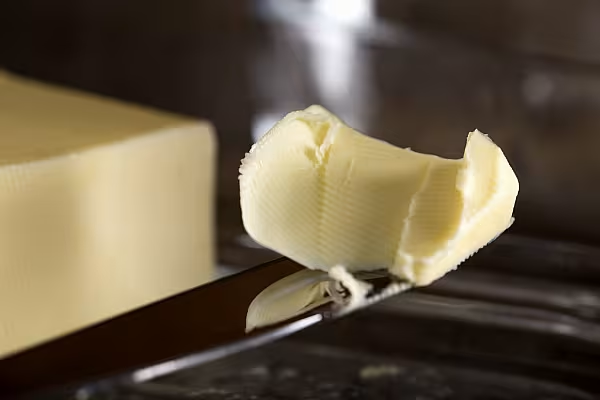Europeans are eating so much butter that the bloc’s stockpiles are nearly empty, adding to a rush of demand that has sent global prices skyrocketing.
The star of the U.S. dairy market in recent years, butter costs have now soared to all-time highs in Western Europe and Oceania. The gains have been aided by shifting consumer views on its healthy attributes and a recent slowdown in the growth of global milk output. France’s Federation of Bakeries has called the price rise a "major crisis."
The U.S. Department of Agriculture boosted its outlook for world consumption and downgraded production in a report this month. In the European Union, one measure of reserves fell to 1,369 tons as of the end of May, a 99 percent plunge from the 92,548 tons held a year ago, the EU said. Butter’s rapid price rise has been “the most notable” shift in international markets, and costs are unlikely to change soon, the USDA says.
“I don’t think we’re out of the woods with higher butter prices,” said Dave Kurzawski, a senior broker at INTL FCStone in Chicago. “What we’ve known about butter for the past 50 years has kind of flipped on its head in the last two-and-a-half or three.”
Global consumption is forecast to climb 3.1 percent to a record 9.7 million tons this year, outstripping the 2.5 percent rise in production, according to the USDA. Consumers are increasingly turning away from vegetable-oil alternatives like margarine and now view butter as “safer,” the USDA said.
Prices Double
Spot prices for butterfat in western Europe have doubled in the past 12 months to a record $7,212.50 per ton, and costs in the region comprising Australia and the Pacific Islands are at an all-time high of $6,150, according to USDA data going back to 2004. Most-active butter futures in Chicago are below the highmark set in 2014, while still trading at a record for this time of year, closing at about $2.69 a pound on Thursday. Futures are up 28 percent this year.
The price moves are a boon to some dairy farmers, who have grappled with slumping international markets in recent years. In 2015, an index of world dairy trade prices plummeted to a 12-year low amid a global milk oversupply after Europe ended a system of expansion quotas. The slump eventually spurred producers to curb output growth.
Keeping Pace
Even as butter prices soar, it’s not easy for supply to keep pace. Output in the EU -- the second-biggest producer behind India -- may dip 3 percent this year amid a drop in milk-fat content and higher processing returns from using milk to make cheese and whey, the European Commission said in a July report.
Some dairy farmers had to switch to cheaper feed during the earlier price drop-off, leading to the decline in milk-fat content used for butter, said Thomas Carstensen, senior vice president of milk and trading at Arla Foods, a Denmark-based cooperative that’s among the world’s largest dairy companies. While production is rebounding, it takes time. The European Commission forecasts milk supply to rise 0.7 percent this year.
Milk is comprised of two key elements: protein and fat. Butter production only utilizes the latter, and the rest is mainly processed into skim milk powder, said Carstensen. Butter’s value in tandem with powder has been less than the combination of cheese, yogurt and fresh milk, he said.
Some grocery stores have been reluctant to raise retail butter prices, and there’s already shortages of retail butter packs in some supermarkets, Alan Wyn-Jones, managing director at South Caernarfon Creameries in Wales, said by email. Cream demand is also strong, making less available to boost butter production, he said.
Milk Powder
The global dairy industry was built around milk-powder growth in recent decades, as demand for products like infant formula rose from developing markets. Most herds are comprised of Holstein cows, a breed that produces high output with lower milk-fat content, said Tom Bailey, an executive director of dairy research for Rabobank in New York. Farms are now adding Jersey cows to boost milk-fat yields.
"Of course we see milk production picking up, but it’s a slow process," Arla Foods’ Carstensen said. “We want to change it, but then you need to have new cows into the stable, new calves becoming cows, you need to change the feeding to increase the yield and that’s just a long process.”
News by Bloomberg, edited by ESM. Click subscribe to sign up to ESM: The European Supermarket Magazine.














